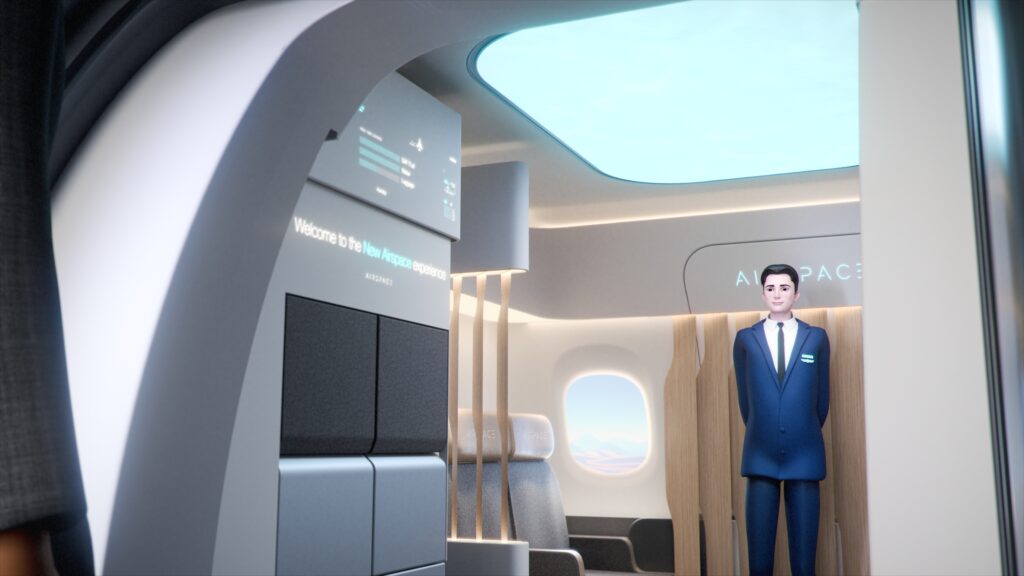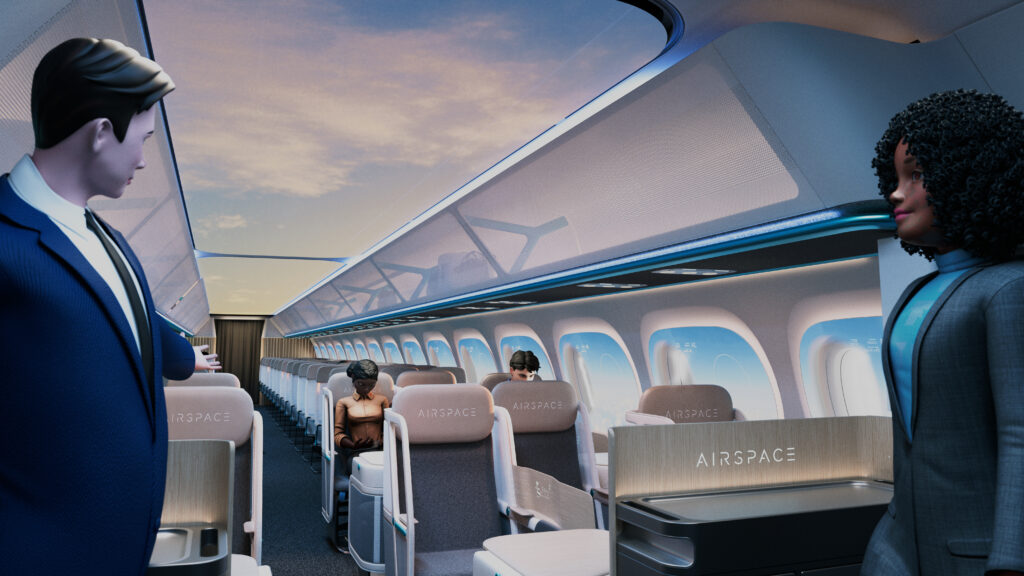Beyond the megatrends of sustainability, digitalisation and individualism, Airbus’ presentation of its Airspace Cabin Vision 2035+ gave a number of interesting clues to Airbus’ future thinking for the passenger experience — and its aircraft.
These concepts follow previous cabin concepts, like the 2011-era Concept Cabin 2050 and 2019’s Airspace Cabin Vision 2030, and showcase how a series of building blocks towards a new cabin might work. Airbus has used this building block metaphor with some success when discussing the technologies and enablers for its future airframe and fuel strategy, so it is notable to see it applied here within the cabin as well, even if named slightly differently.
After an introduction and quick canter through of aviation sustainability from chief marketing officer Stan Shparberg, head of cabin marketing Ingo Wuggetzer highlighted three of these building blocks — which he called pillars — that will most affect the way the cabin of the future looks and works.
The three pillars of the 2035+ cabin
The first pillar is transparency, and here Wuggetzer notes that “we really want to do a paradigm shift in how we calculate and optimise our products in the cabin,” particularly by increasing the use of full lifecycle analysis.
Airbus’ approach, Wuggetzer says, will be “based on an end to end lifecycle assessment, it takes decisions, how to design products, how to retrofit products, or how to customise — that starts with the layout of the products passengers will experience in the end.”
This will require a substantial change in approach from many elements of the supply chain, including around sharing data to feed into that this lifecycle analysis.
“For this, of course,” Wuggetzer notes, “it is digitalisation that is key to achieve end to end data availability.”
The second pillar is decarbonisation, and here Wuggetzer identified that between 10-20 per cent of an aircraft’s total lifecycle environmental analysis is within the cabin, based on an internal Airbus lifecycle analysis for the A350.
In response to a question from Runway Girl Network around the percentage of that is purely down to weight, Wuggetzer noted that, “actually, the major part is weight: so we see that weight is about 10, 15%. You add about another quarter that is due to other operational topics, but the weight is the big, big lever in terms of operations.”
Here, Airbus estimates that using bionic design and biomimicry it might be able to reduce weight for all structural and lining elements — on galleys, on bins, on lining parts — by up to 40 per cent.
Also within decarbonisation falls a revolutionary change to catering concepts — including a full rethink of shorthaul catering, eliminating trolleys in favour of pre-ordered at-the-gate self-service boxes, and a change in the longhaul catering model to use pre-ordering to reduce waste. For shorthaul, Airbus estimates some 15 per cent reduction in weight and waste, and for longhaul it predicts a 35 per cent reduction in trolleys by creating a new catering stowage concept.
This will, of course, require a major change in the way that aircraft are catered and airports are laid out, but in the context of changes like those needed to use blended wing bodies it is perhaps not the greatest challenge facing aviation in the next fifteen years.
The third pillar — which Wuggetzer describes as “the hardest to achieve, because you need to change your philosophy” — is circularity. Here, the vision is an aviation industry that prioritises, on an end-to-end basis:
- rethink
- recycle
- repair
- reuse
The first example Wuggetzer used here was a sidewall panel, made from the 100 per cent reused waste of A350 carbon production, 18 kilograms lighter than today for an A350 shipset.
The second example is endless recycling of cabin polymer plastics at the same rung on the value ladder. This expands on what is done today, where a cabin element that can be separated into its constituent plastics at the end of its life might be turned into a warehouse tray, which at the end of its own life might be turned into an underground utility pipe.
Reuse of cabin plastics has not previously been widely successful, largely due to the need for plastic feedstocks to have repeatable certification certainty around toxicity, flammability, and structural integrity, which by and large requires virgin plastics today.
Future concept aesthetic remains disassociated from the likely PaxEx of tomorrow — and today
Generally, any glimpse into the future of passenger cabin concepts is notable for both what it shows and what it doesn’t show, and the Airspace Cabin Vision 2035+ is no exception.
Airbus showed both a fairly traditional six-abreast narrowbody tube and a larger widebody aircraft that, from the shape and structure of the cabin, might well be some sort of blended wing body concept.
The narrowbody was striking in in several ways. First, the evolution of the Airspace branding element on boarding includes a door 1L entryway free of industrial-type galleys, presumably owing to the at-the-gate model.
The cabin in this aircraft is almost entirely covered in individual, separate screen elements: double-window screens surrounding each pair of windows, plus screens along the full length of the ceiling.
The layout includes an unusual 3-3 stagger in the premium section before a narrower 3-3 layout in what looks like regular economy. Neither of these seem particularly realistic (or, subjectively to your author, attractive) in real world terms, not least because there is no separation between classes and the premium seating aisle is narrower than that down the back.

Not only are all seats numbered 3A, but it would be good to see some more ideas about how these heavy, hot, power-intensive screens might be used. Image: Airbus
The most aspirationally concept of all the elements, however, has to be the knitted-screen overhead bins — not because of their ultra-light, semi-transparent bin nature, but because they are so tiny. They resemble a 1960s hatrack rather than a modern bin, and stretching over perhaps one and a half seats of cabin width rather than the three seats of today’s bins… no wonder the cabin feels airy.
On the widebody cabin, we have three kinds of seat sharing the same spacious cabin with the aesthetics of a planetarium in a cyberpunk forest. Economy are at the back in a 3-6-3 layout (come back five-abreast A380, all is forgiven), with the same premium seats from the narrowbody staggering in front, plus a front row of entirely different seats. No overhead bins are visible, which (among other factors) suggests that this is very much more of a hypothetical than the narrowbody.
All in all, with 2035 just around the corner, it feels a little disappointing that these attractive sci-fi cabins feel so removed from the actual — or indeed likely — passenger experience. Technology moves fast, but the difference between, say, an iPad of twelve years ago and an iPad today is not on the same scale as the difference between even the most admirably kitted out cabin today and these cabins with displays on every surface.
Indeed, with weight such an impact, how much do all these screens weigh? How much power do they use? How robust are they in an impact? We know that seatmakers are still having trouble certifying screens to fit on the back of an economy class seat. The idea of stretching our legs in front of an enormous curved panoramic wall and watching a large hydrogen widebody twinjet fly over craggy mountain peaks ahead of us may seem idyllic. But a lack of joining up the dots between these airy, mood-lit concepts and, say, Lufthansa’s “discreet” A321neo Airspace cabin, is perhaps a missed trick.

What are the steps — multiple — to get from today’s front of an aircraft to this 2035+? Image: Airbus
Related Articles:
- JetZero and Factorydesign unveil cabin concepts for BWB jet
- Airbus advances design of Airspace Link smart platform
- Designing the self-aware cabin of the very near future
- What passenger experience future for Airbus hydrogen aircraft?
- Press Release: TU Delft answers your questions about the Flying-V
Featured image credited to Airbus














